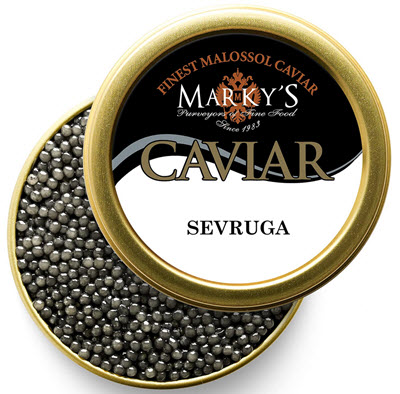Sevruga caviar
Sevruga is one of the more expensive types of caviar, but usually not as pricy as Beluga and Ossetra.
 Sevruga caviar is made from the roe of the Sevruga sturgeon (Acipenser stellatus). Among the sturgeons commonly farmed for their roe, Sevruga is one of the smallest. It is slim-bodied and the longest specimens on record were circa 220 long and weighed around 80 kg.
Sevruga caviar is made from the roe of the Sevruga sturgeon (Acipenser stellatus). Among the sturgeons commonly farmed for their roe, Sevruga is one of the smallest. It is slim-bodied and the longest specimens on record were circa 220 long and weighed around 80 kg.
The Sevruga sturgeon is listed as Critically Endangered on the IUCN Red List 3.1. That is the most serious level for species in the wild; the next step would be Extinct in the Wild.
Nowadays, it is possible to purchase Sevruga caviar that comes from farm-raised Sevruga sturgeons.
Eating Sevruga caviar
Sevruga eggs are smaller than Beluga and Ossetra eggs. It doesn´t mean that they are tiny; just not as large as the famously big Belugas and Ossetras.
Sevruga eggs are pearlescent and gray, and the taste is typically stronger than that of Beluga and Ossetra. The origin of the Sevruga sturgeons can impact the taste of the caviar.
For historic reasons, Sevruga caviar is often sold in red containers.
Just like other types of caviar, Sevruga caviar should not be frozen, as it will cause the roe to burst and change the taste and culinary experience. Another advice regarding all kinds of caviar is to avoid using metal spoon, as contact with metal can make the caviar taste metallic. A wooden spoon or bone spoon is much better, or a spoon where mother-of-pearl covers the area that will be in contact with the caviar.
The Sevruga sturgeon
- Order: Acipenseriformes
- Family: Acipenseridae
- Genus: Acipenser
- Species: A. stellatus
The Sevurga sturgeon lives in the Black Sea, Caspian Sea, and Azov Sea basins. Fairly recently, it was still present in the Aegean Sea part of the Meditteranian as well, but now it is considered extinct from the Aegean Sea. Historically, it was found in a much larger area, including rivers in Central- and Eastern Europe.
As mentioned above, the Sevruga sturgeon is Critically Endangered in the wild. One of the main reasons behind its decline is overfishing. It is not just fished for its roe; it is also a popular food fish within its native range.
The Sevruga sturgeon migrates to freshwater to spawn. The female will not be ready to spawn until she is 7-10 years old, which is one of the reasons why the species is so vulnerable to overfishing. Among Sevruga caviar connoisseurs, eggs from a female who is at least 18-22 years of age are considered especially desirable.
